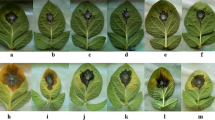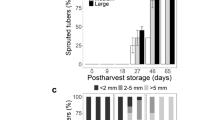Abstract
In order to optimize potato crop management in organic farming systems, knowledge of crop growth processes in relation to limitations and reductions by nitrogen (N) and disease is necessary. This paper examines the effect of different prevention measures (seed tuber pre-sprouting, choice of cultivars: resistance to Phytophthora infestans; earliness of tuber initiation) against disease-related constraints on yields, depending on the N-mediated growing conditions of organic potato crops. Under conditions of a relatively high N supply, accelerating the early development and tuber initiation of potato crops by seed tuber pre-sprouting (yield increase of c. 18–23%) or the selective choice of cultivars with an earlier tuber initiation (yield increase of c. 0–21%) are the most effective strategies in combating late blight. They bring forward the crop development c. 7–10 days, escaping the negative impact of the fungus on tuber growth. Under conditions of a relatively low N supply, these strategies do not affect final tuber yield. The reason for the differences of the effect depending on N supply of the crops is, that the lower the N supply, the shorter the period of time over which tuber growth takes place, independent of whether P. infestans becomes severe or not. Tuber growth of organic crops low in N has mostly ceased by the time late blight becomes potentially important for limiting yield, with the consequence that preventative measures against P. infestans are meaningless. Surprisingly, the level of cultivar haulm resistance to late blight did not affect tuber yields in years with an early and strong late blight development. Probably, the positive effect of a longer resistance to the fungus (c. 1 week) was counterbalanced by a later tuber initiation (also c. 1 week). In years with a moderate late blight incidence, less susceptible cultivars were able to produce higher tuber yields on fields with a lower N availability (c. 17–20%), probably due to higher N use efficiency and a better match of N mineralization and N uptake. Under conditions of a relatively high N supply, the tested cultivars with a higher haulm resistance to late blight were not able to improve tuber yields.
Similar content being viewed by others
References
Beukema HP, Zaag DE van der (1990) Introduction to potato production. Pudoc, Wageningen, Netherlands.
Caldwell RM, Schafer JE (1958) Tolerance to cereal leaf rust. Science 128:714–715
Errebhi M, Rosen CJ, Lauer FI, Martin MW, Bamberg JB, Birong DE (1998) Screening of exotic potato germplasm for nitrogen uptake and biomass production. Am J Pot Res 75:93–100
Finckh MR, Schulte-Geldermann E, Bruns C (2006) Challenges to organic potato farming: disease and nutrient management. Potato Res 49:27–40
Finckh MR, Schulte-Geldermann E, Musa T, Forrer HR, Bruns C (2007) Effects of Phytophthora infestants on potato yields as influenced by nutrient status and optimized copper applications. In: Zikeli S, Claupein W, Dabbert S, Kaufmann B, Müller T, Valle Zárate A (eds) Beiträge zur 9. Wissenschaftstagung Ökologischer Landbau, Band 1. Univ. Hohenheim 20-23 March, 2007, pp. 353–356, http://orgprints.org/9601/01/9601_Finckh_Poster.pdf
Gunasena HPM, Harris PM (1968) The effect of the time of application of nitrogen and potassium on the growth of the second early potato, variety Craig’s Royal. J Agric Sci Camb 71:283–296
James WC, Shih CS, Hodgson WA, Callbeck CL (1971) The quantitative relationship between late blight of potato and loss in tuber yield. Phytopathology 62:92–96
Jefferies RA, MacKerron DKL (1987) Thermal time as a non-destructive method of estimating tuber initiation in potatoes. J Agric Sci Camb 108:249–252
Karalus W, Rauber R (1997) Effect of presprouting on yield of maincrop potatoes (Solanum tuberosum L.) in organic farming. J Agron Crop Sci 179:241–249
Large EC (1952) The interpretation of progress curves for potato blight and other plant diseases. Plant Path 1:109–117
Möller K (2003) Attempts to reduce copper applications in organic potatoe production. In: Kühne S, Friedrich B (eds) Beiträge zum 7. Fachgespräch Pflanzenschutz im ökologischen Landbau an der Biologischen Bundesanstalt für Land- und Forstwirtschaft zum Thema Pflanzenschutz im ökologischen Landbau – Probleme und Lösungsansätze“. Berichte aus der Biologischen Bundesanstalt für Land- und Forstwirtschaft 118: 56–66, http://orgprints.org/1069/
Möller K, Habermeyer J, Zinkernagel V, Reents HJ (2006) Impact and interaction of nitrogen and Phytophthora infestans as yield-limiting and yield reducing factors in organic potato crops. Potato Research 49(4):281–301
Ross H. (1986) Potato Breeding—Problems and Perspectives. Fortschritte der Pflanzenzüchtung 13. Parey, Berlin and Hamburg.
Schleusener W (1952) Einfluss von Pflanzzeit und Keimstimmung auf den Kartoffelertrag. Die Deutsche Landwirtschaft 3:119–123
Speiser, B, Tamm L, Amsler T, Lambion J, Bertrand C, Hermansen A, Ruissen MA, Haarland P, Zarb J, Santos J, Shotton P, Wilcockson S, Juntharathep P, Ghorbani R, Leifert C (2006) Improvement of Late Blight Management in Organic Potato Production Systems in Europe: Field Tests with More Resistant Potato Varieties and Copper Based Fungicides. Biol Agric Hortic 23:393–412
Ulrich G (1957) Ertragssteigerung bei Kartoffeln auf schweren Böden durch Frühpflanzung und Vorbehandlung des Pflanzgutes. Z Acker- und Pflanzenbau 104:145–168
Umaerus V, Umaerus M (1994) Inheritance of Resistance to Late Blight. In: Bradshaw JE, Mackay GR (eds) Potato Genetics. CAB International, Wallingford, pp 365–401
van Delden A, Schröder JJ, Kropff MJ, Grashoff C, Booij R (2003) Simulated potato yield, and crop and soil nitrogen dynamics under different organic nitrogen management strategies in The Netherlands. Agric Ecosyst Environ 96:77–95
Visker MHPW, van Raaij HMG, Keizer LCP, Struik PC, Colon LT (2004) Correlation between late blight resistance and foliage maturity type in potato. Euphytica 137:311–323
Vos J (1995) Nitrogen and the growth of potato crops. In: Haverkort AJ, MacKerron DKL (eds) Potato Ecology and Modelling of Crops under Conditions Limiting Growth. Kluwer, Dordrecht, pp115–128
Zebarth, BJ, Tai G, Tarn R, de Jong H, Milburn PH (2004) Nitrogen use efficiency characteristics of commercial potato cultivars. Can J Plant Sci 84:589–598
Author information
Authors and Affiliations
Corresponding author
Rights and permissions
About this article
Cite this article
Möller, K., Reents, HJ. Impact of Agronomic Strategies (Seed Tuber Pre-sprouting, Cultivar Choice) to Control Late Blight (Phytophthora infestans) on Tuber Growth and Yield in Organic Potato (Solanum tuberosum L.) Crops. Potato Res. 50, 15–29 (2007). https://doi.org/10.1007/s11540-007-9026-5
Received:
Accepted:
Published:
Issue Date:
DOI: https://doi.org/10.1007/s11540-007-9026-5




